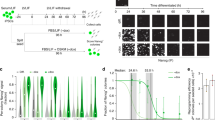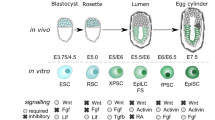Abstract
Cell fate during development is defined by transcription factors that act as molecular switches to activate or repress specific gene expression programmes. The POU transcription factor Oct-3/4 (encoded by Pou5f1) is a candidate regulator in pluripotent and germline cells1,2,3,4 and is essential for the initial formation of a pluripotent founder cell population in the mammalian embryo5. Here we use conditional expression and repression in embryonic stem (ES) cells to determine requirements for Oct-3/4 in the maintenance of developmental potency. Although transcriptional determination has usually been considered as a binary on-off control system, we found that the precise level of Oct-3/4 governs three distinct fates of ES cells. A less than twofold increase in expression causes differentiation into primitive endoderm and mesoderm. In contrast, repression of Oct-3/4 induces loss of pluripotency and dedifferentiation to trophectoderm. Thus a critical amount of Oct-3/4 is required to sustain stem-cell self-renewal, and up- or downregulation induce divergent developmental programmes. Our findings establish a role for Oct-3/4 as a master regulator of pluripotency that controls lineage commitment and illustrate the sophistication of critical transcriptional regulators and the consequent importance of quantitative analyses.
This is a preview of subscription content, access via your institution
Access options
Subscribe to this journal
Receive 12 print issues and online access
$209.00 per year
only $17.42 per issue
Buy this article
- Purchase on Springer Link
- Instant access to full article PDF
Prices may be subject to local taxes which are calculated during checkout






Similar content being viewed by others
References
Schöler, H.R., Ruppert, S., Suzuki, N., Chowdhury, K. & Gruss, P. New type of POU domain in germ line-specific protein Oct-4. Nature 344, 435– 439 (1990).
Rosner, M.H. et al. A POU-domain transcription factor in early stem cells and germ cells of the mammalian embryo. Nature s345, 686–692 (1990).
Okamoto, K. et al. A novel octamer binding transcription factor is differentially expressed in mouse embryonic cells. Cell 60, 461–472 (1990).
Pesce, M., Wang, X., Wolgemuth, D.J. & Scholer, H. Differential expression of the Oct-4 transcription factor during mouse germ cell differentiation. Mech. Dev. 71, 89– 98 (1998).
Nichols, J. et al. Formation of pluripotent stem cells in the mammalian embryo depends on the POU transcription factor Oct-4. Cell 95, 379–391 (1998).
Gossen, M. & Bujard, H. Tight control of gene expression in mammalian cells by tetracycline-responsive promoters. Proc. Natl Acad. Sci. USA 89, 5547–5551 (1992).
Mountford, P. et al. Dicistronic targeting constructs: reporters and modifiers of mammalian gene expression. Proc. Natl Acad. Sci. USA 91, 4303–4307 (1994).
Gassmann, M., Donoho, G. & Berg, P. Maintenance of an extrachromosomal plasmid vector in mouse embryonic stem cells. Proc. Natl Acad. Sci. USA 92, 1292–1296 (1995).
Niwa, H., Burdon, T., Chambers, I. & Smith, A.G. Self-renewal of pluripotent embryonic stem cells is mediated via activation of STAT3. Genes Dev. 12, 2048–2060 (1998).
Smith, A. G. et al. Inhibition of pluripotential embryonic stem cell differentiation by purified polypeptides. Nature 336 , 688–690 (1988).
Saijoh, Y. et al. Identification of putative downstream genes of Oct-3, a pluripotent cell-specific transcription factor. Genes Cells 1, 239–252 (1996).
Arceci, R.J., King, A.A., Simon, M.C., Orkin, S.H. & Wilson, D.B. Mouse GATA-4: a retinoic acid-inducible GATA-binding transcription factor expressed in endodermally derived tissues and heart. Mol. Cell. Biol. 13, 2235– 2246 (1993).
Wilkinson, D.G., Bhatt, S. & Herrmann, B.G. Expression pattern of the mouse T gene and its role in mesoderm formation. Nature 343, 657– 659 (1990).
Nishikawa, S.I., Nishikawa, S., Hirashima, M., Matsuyoshi, N. & Kodama, H. Progressive lineage analysis by cell sorting and culture identifies FLK1+VE-cadherin+ cells at a diverging point of endothelial and hemopoietic lineages. Development 125, 1747–1757 (1998).
Hebert, J.M., Boyle, M. & Martin, G.R. mRNA localization studies suggest that murine FGF-5 plays a role in gastrulation. Development 112, 407–415 (1991).
Cserjesi, P., Brown, D., Lyons, G.E. & Olson, E.N. Expression of the novel basic helix-loop-helix gene eHAND in neural crest derivatives and extraembryonic membranes during mouse development. Dev. Biol. 170, 664–678 (1995).
Beck, F., Erler, T., Russell, A. & James, R. Expression of Cdx-2 in the mouse embryo and placenta: possible role in patterning of the extra-embryonic membranes. Dev. Dyn. 204, 219–227 (1995).
Brook, F.A. & Gardner, R.L. The origin and efficient derivation of embryonic stem cells in the mouse. Proc. Natl Acad. Sci. USA 94, 5709–5712 ( 1997).
Beddington, R.S.P. & Robertson, E.J. An assessment of the developmental potential of embryonic stem cells in the midgestation mouse embryo. Development 105, 733– 737 (1989).
Tanaka, S., Kunath, T., Hadjantonakis, A.-K., Nagy, A. & Rossant, J. Promotion of trophoblast stem cell proliferation by FGF-4. Science 282, 2072 –2075 (1998).
Ambrosetti, D.-C., Basilico, C. & Dailey, L. Synergistic activation of the fibroblast growth factor 4 enhancer by sox2 and oct-3 depends on protein-protein interactions facilitated by a specific spatial arrangement of factor binding sites. Mol. Cell. Biol. 17, 6321–6329 (1997).
Nishimoto, M., Fukushima, A., Okuda, A. & Muramatsu, M. The gene for the embryonic stem cell coactivator UTF1 carries a regulatory element which selectively interacts with a complex composed of Oct-3/4 and Sox-2. Mol. Cell. Biol. 19, 5453–5465 (1999).
Schöler, H.R., Ciesiolka, T. & Gruss, P. Anexus between Oct-4 and E1A: implications for gene regulation in embryonic stem cells. Cell 66, 291–304 (1991).
Ben-Shushan, E., Thompson, J.R., Gudas, L.J. & Bergman, Y. Rex-1, a gene encoding a transcription factor expressed in the early embryo, is regulated via Oct-3/4 and Oct-6 binding to an octamer site and a novel protein, Rox-1, binding to an adjacent site. Mol. Cell. Biol. 18, 1666–1878 (1998).
Botquin, V. et al. New POU dimer configuration mediates antagonistic control of an osteopontin preimplantation enhancer by Oct-4 and Sox-2. Genes Dev. 12, 2073–2090 (1998).
Burdon, T., Chambers, I., Niwa, H., Stracey, C. & Smith, A.G. Signalling mechanisms regulating self-renewal and differentiation of pluripotent embryonic stem cells. Cells Tissues Organs 165, 131–143 ( 1999).
Dani, C. et al. Paracrine induction of stem cell renewal by LIF-deficient cells: a new ES cell regulatory pathway. Dev. Biol. 203, 149–162 (1998).
Palmieri, S.L., Peter, W., Hess, H. & Schöler, H.R. Oct-4 transcription factor is differentially expressed in the mouse embryo during establishment of the first two extraembryonic cell lineages involved in implantation. Dev. Biol. 166, 259–267 (1994).
Niwa, H., Yamamura, K.-I. & Miyazaki, J.-I. Efficient selection for high-expression transfectants with a novel eukaryotic vector. Gene 108, 193–200 (1991).
Shimazaki, T. et al. Hybrid cell extinction and re-expression of Oct-3 function correlates with differentiation potential. EMBO J. 12, 4489–4498 (1993).
Acknowledgements
We thank S. Nishikawa for access to time-lapse recording facilities and H. Schöler and H. Hamada for anti-Oct-3/4 antisera. We acknowledge F. Stehnouse for technical assistance. This work was supported by the Biotechnology and Biological Sciences Research Council of the United Kingdom, The Ministry of Education, Science and Culture of Japan, and a Uehara Memorial Foundation Award to H.N.
Author information
Authors and Affiliations
Corresponding authors
Supplementary information
Rights and permissions
About this article
Cite this article
Niwa, H., Miyazaki, Ji. & Smith, A. Quantitative expression of Oct-3/4 defines differentiation, dedifferentiation or self-renewal of ES cells. Nat Genet 24, 372–376 (2000). https://doi.org/10.1038/74199
Received:
Accepted:
Issue Date:
DOI: https://doi.org/10.1038/74199
This article is cited by
-
Mitotic bookmarking redundancy by nuclear receptors in pluripotent cells
Nature Structural & Molecular Biology (2024)
-
Epigenetic OCT4 regulatory network: stochastic analysis of cellular reprogramming
npj Systems Biology and Applications (2024)
-
Transcriptional repression upon S phase entry protects genome integrity in pluripotent cells
Nature Structural & Molecular Biology (2023)
-
CasTuner is a degron and CRISPR/Cas-based toolkit for analog tuning of endogenous gene expression
Nature Communications (2023)
-
Hyaluronic acid and multiwalled carbon nanotubes as bioink additives for cartilage tissue engineering
Scientific Reports (2023)



